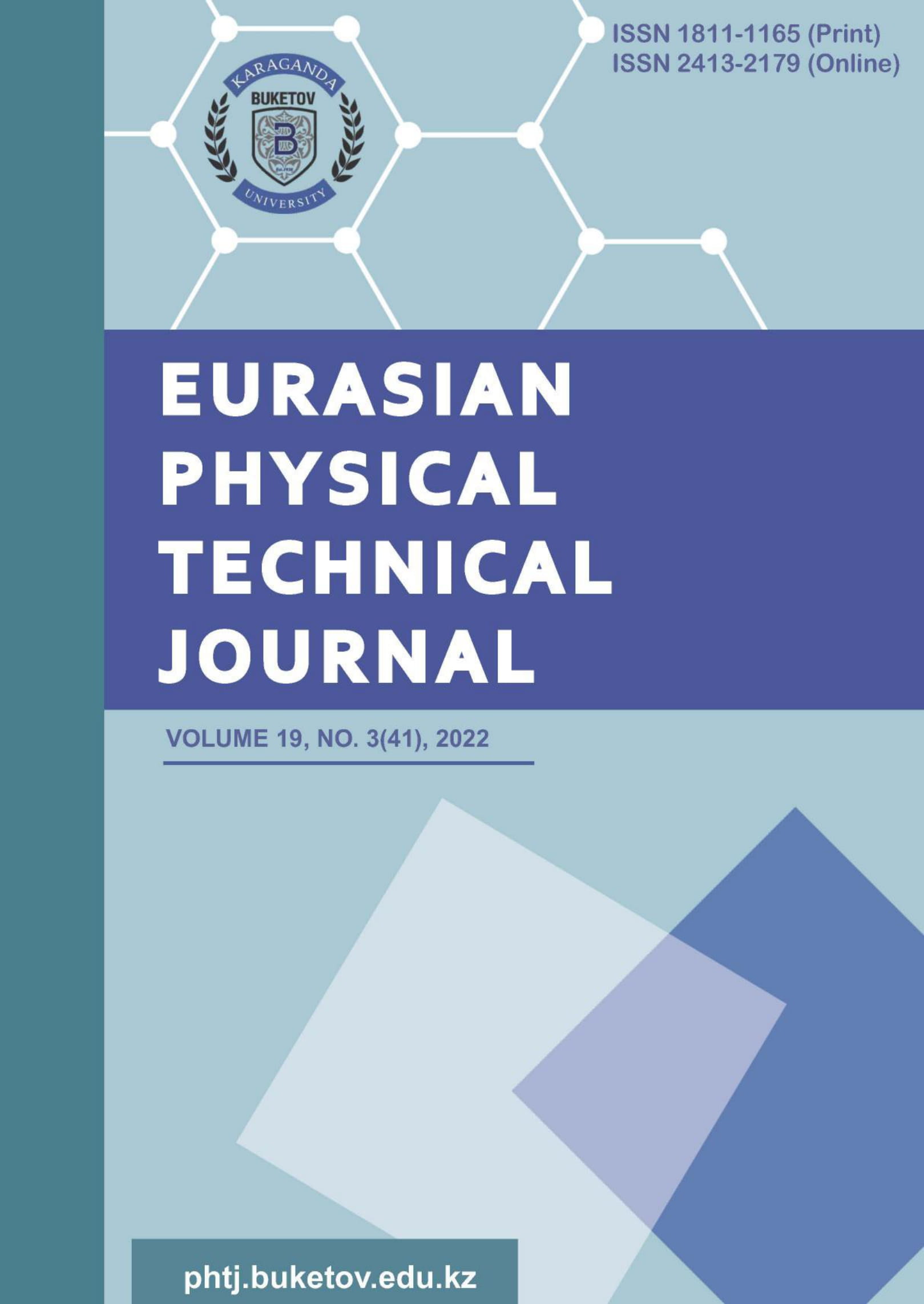INVESTIGATION OF THE ENERGY DEPENDENCE OF THE INTERACTION POTENTIALS OF THE 16O+12С NUCLEAR SYSTEM WITH A SEMI-MICROSCOPIC METHOD
DOI:
https://doi.org/10.31489/2022No3/39-44Keywords:
elastic scattering, folding model, matter density distribution, nucleon-nucleon interactionAbstract
The study of the collision of heavy ions with light nuclei at low energy is important in nuclear physics,
thermonuclear energy, and astrophysics. The high-precision values of the nuclear system described at an energy
close to the Coulomb barrier are used to control the synthesis of light nuclei inside thermosynthesis. For cross
sections of reactions of light nuclei on the sun, plasma, and stars, we can use the parameters we have set. The
article presents a microscopic approach to describing the process of nuclear-nuclear interaction. In the
phenomenological approach, which determines empirical values based on comparison with experimental data, it
is possible to find many sets of parameters with potentials that characterize the cross-section well. But the
question arises which of them are real. Therefore, it is necessary to additionally describe microscopic potentials.
For the same reason, a semi-microscopic analysis was carried out, which describes the imaginary part of the
nuclear potential on the basis of an optical model, and the real part on a double-folding model. The folding
potential is constructed depending on the effective nucleon-nucleon interaction based on the matrix element of two
nucleons and the density of the nucleon distribution. As a result of the analysis, differential cross sections and
optimal parameters were determined that well characterize the experimental cross sections of the 16О+12C
nuclear system at energies ELab=20, 24, 36 MeV. The coefficients of normalization of differential cross sections,
described on the basis of real microfolding potentials, were determined in the range N=0.85-1.0.
References
Khoa D.T., Knjaz'kov O.M. Obmennye effekty v yadro-yadernyh potencialah i yadernoe raduzhnoe rassejanie. Fizika jelementarnyh chastic i atomnogo yadra. 1990. Vol. 21, No. 6, pp. 1456-1498. [in Russian]
Tanihata I., Hamagaki H., Hashimoto O. Measurements of interaction cross sections and nuclear radii in the light p-shell region. Physical Review Letters. 1985. Vol. 55, No.24, pp. 2676. doi.org/10.1103/PhysRevLett.55.2676.
Khoa D.T. α-nucleus optical potential in the double-folding model. Physical Review C. 2001. Vol.63, No.3, pp. 034007. doi.org/10.1103/PhysRevC.63.034007.
Von Oertzen W., Khoa D.T., Bohlen H.G. At the end of the rainbow an understanding of nuclear matter. Europhysics News. 2000. Vol.31 No.2, pp. 5-9.
Kobos A.M., Brown B.A., Lindsay R. Folding-model analysis of elastic and inelastic α-particle scattering using a density-dependent force. Nuclear Physics A.1984. Vol. 425, No.2, pp. 205-232. doi: 10.1016/0375-9474(84)90073-3.
Lukyanov V.K., Zemlyanaya E.V. Total cross sections for nucleus-nucleus reactions within the Glauber-Sitenko approach for realistic distributions of nuclear matter. Physics of Atomic Nuclei. 2004. Vol.67, No.7, pp.1282-1298.
Anantaraman N., Toki H., Bertsch G.F. An effective interaction for inelastic scattering derived from the Paris potential. Nuclear Physics A. 1983. Vol.398, No.2, pp. 269-278. doi.org/10.1016/0375-9474(83)90487-6.
Satchler G.R. Direct Nuclear Reactions. Oxford Univ. Press, New York, 1983.
Bertsch G., Borysowicz J., McManus H. Interactions for inelastic scattering derived from realistic potentials. Nuclear Physics A. 1977. Vol.284, No.3, pp. 399-419. https://doi.org/10.1016/0375-9474(77)90392-X.
Khoa D.T, Oertzen V.W, Bohlen H.G. Double-Folding Model for Heavy ion Optical Potential: Revised and Applied to Study 12C and 16O Elastic Scattering. Physical Review C.1994. Vol.49, pp.1652-1667.
Ehrenberg H.F., Hofstadter R., Meyer-Berkhout U. High-energy electron scattering and the charge distribution of carbon-12 and oxygen-16. Physical Review. 1959. Vol.113, No.2, pp. 666.
De Jager C.W., De Vries H., De Vries C. Nuclear charge-and magnetization-density-distribution parameters from elastic electron scattering. Atomic data and nuclear data tables. 1974. Vol.14, No.5, pp. 479-508.
De Vries H., et al. Nuclear charge-density-distribution parameters from elastic electron scattering. Atomic data and nuclear data tables. 1987. Vol. 36(3), pp. 495-536. doi.org/10.1016/0092-640X(87)90013-1.
Gupta S.K., Sinha B. Intrinsic density and energy dependence: Exchange effects in alpha-nucleus scattering. Physical Review C. 1984. Vol.30 No.3, pp.1093. doi.org/10.1103/PhysRevC.30.1093.
Gontchar I.I., Chushnyakova M.V. A C-code for the double folding interaction potential of two spherical nuclei. Computer Physics Communications. 2010. Vol.181, No.1, pp.168-182.
Voos U.C., Von Oertzen W., Bock R. Optical-model analysis of the elastic scattering of complex nuclei at low energies. Nuclear Physics A, 1969. Vol.135. No.1, pp. 207-224. doi.org/10.1016/0375-9474(69)90159-6.
Khoa D.T., Satchler G.R., Von Oertzen W. Nuclear incompressibility and density dependent NN interactions in the folding model for nucleus-nucleus potentials. Physical Review C. 1997. Vol.56, No.2, pp. 954. doi.org/10.1103/PhysRevC.56.954.
Khoa D.T., Von Oertzen W. Refractive alpha-nucleus scattering: a probe for the incompressibility of cold nuclear matter. Physics Letters B. 1995. Vol.342 No.1, pp. 6-12. doi.org/10.1016/0370-2693(94)01393-Q.
Khoa D.T., Satchler G.R. Generalized folding model for elastic and inelastic nucleus–nucleus scattering using realistic density dependent nucleon–nucleon interaction. Nuclear Physics A. 2000. Vol.668, No.1, pp. 3-41.
Soldatkhan D., et al. New Measurements and Theoretical Analysis for the 16O+ 12C Nuclear System. Brazilian Journal of Physics. 2022. Vol. 52, No.5, pp. 1-10. doi.org/10.1007/s13538-022-01153-0.













